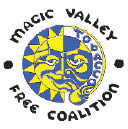While smoking has decreased significantly among youth since the funding of anti-tobacco programs through the Master Settlement Agreement in 1998, data from the National Institute on Drug Abuse suggest that the decline has stalled over the past few years. Much of that stall can be attributed to two factors: More states reduced anti-tobacco program funding in recent years, and tobacco companies have stepped up their marketing toward young people.
Because more than 20 percent of high school seniors still smoke, youth advocates in the anti-tobacco field say now is not the time to stop funding anti-tobacco programs. But do those programs work?
Youth-focused anti-smoking programs have garnered some of the credit for a 40 percent decline in smoking among high schoolers from 1997 to 2003. But parsing out the contribution of such efforts is impossible. The approaches differ significantly, and youth workers don’t always agree on what’s effective.
April Kusper, director of youth advocacy for the Washington-based Campaign for Tobacco-Free Kids (CTFK), says efforts that take on “Big Tobacco” itself have been particularly successful. “Kids have a hard time connecting with ‘I’m going to die from tobacco use 40 years from now,’” she says. “But they don’t like the idea that they’re being targeted by Big Tobacco as a replacement market.”
That’s why the Saratoga County, N.Y., branch of Reality Check, a statewide youth-led program, focuses on attacking the tobacco industry. “The biggest issue is that teens believe they are invincible,” says Coordinator Lauren Rowland. “They’re not concerned with how doing something now will affect them in 20 years.”
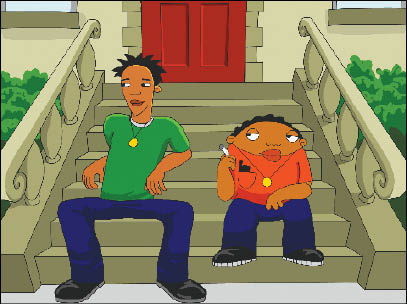 |
|
Interactive, animated clips – here featuring siblings talking about the effects of smoking – are part of ASPIRE’s curriculum.
Photo: M.D. Anderson Cancer Center.
|
So Reality Check doesn’t really target smokers with messages about health. “We don’t hit them over the head with anti-tobacco facts,” Rowland says.
Does it work to hit the tobacco companies instead? Well, New York is one of the few states where the decline in youth tobacco use has not stalled. From 2000 to 2006, tobacco use among high school students there fell by 40 percent.
In Twin Falls, Idaho, local kids take a different approach, trying to influence legislation. The Magic Valley Tobacco-Free Coalition petitions state and federal legislators about anti-tobacco measures, and encourages local businesses and organizations to go smoke-free.
The group also runs elementary school programs taught by teens. Kusper at CTFK believes that campaigns are most effective when young people lead the charge. She says youth-led campaigns are better at jumping the hurdle of getting kids’ attention. “They have access to so much media,” Kusper says, that competing for their time is difficult. “Plus, their attention spans are short.”
An experimental program in Texas suggests that youth can be steered away from tobacco use on an individual level, involving minimal interaction with other youth or adults. The M.D. Anderson Cancer Center at the University of Texas developed a CD-Rom called ASPIRE, which allows kids on computers to select a program that best fits their specific circumstances. “Non-smokers get information on how never to become smokers, for example, and training on how to become tobacco control advocates,” says ASPIRE’s lead developer, Dr. Alexander Prokhorov. Smokers, on the other hand, learn behavior techniques to help them quit.
“We need to do this in a personalized way,” Prokhorov contends. “Kids all have different needs and cultural diversity. Computer technology lets us tailor the program better to individual circumstances.”
Some anti-tobacco programs still operate by the tried-and-true method of conducting outreach in classrooms. For example, at the Rockbridge County branch of the Virginia Tobacco Settlement Foundation program, prevention educators visit classrooms weekly to teach about the harm of tobacco use and healthier ways to handle stress and deal with peer pressure.
A crucial element, says Program Coordinator Kelly Shifflett, is delivering the program to the youths repeatedly, in different forms, year after year from second through ninth grades. “Kids need the reinforcement of positive social skills and managing their emotions,” she says. “It’s so much more comprehensive than just teaching kids not to light up.”
An increasing number of anti-tobacco programs focus on teaching youth about healthy emotional and physical lifestyles, as opposed to using scare tactics that show them what their lungs will look like in 30 years.
Regardless of their approach, just about all anti-tobacco programs are contending with funding cuts. Even the American Legacy Foundation’s popular “truth” campaign saw a decline, with the expiration of contributions from the Master Settlement Agreement. Most states are funding anti-tobacco programs at levels lower than those recommended by the Centers for Disease Control and Prevention.
The following programs are doing a lot with a little, in part by using youth themselves to get the word out.
Magic Valley Tobacco-Free Coalition
South Central Public Health District
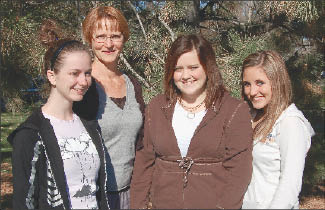 |
|
Pushy: Coalition members (left to right) Liz Warren, Katie Christiansen and Taylor Pulsipher, with adult coordinator Tami Pearson, are pushing for a state tax increase on tobacco products.
Photo: Magic Valley Tobacco-Free Coalition
|
Twin Falls, Idaho
(208) 737-5945
The Approach: This youth-led coalition is primarily a lobbying group that tries to influence local, state and federal governments to pass anti-tobacco legislation. The group has joined others in pushing for a state tax increase on tobacco products, and is attempting to get part of the College of Southern Idaho’s campus to go smoke-free. The group’s adult coordinator, district Health Education Specialist Tami Pearson, says kids influence legislation through petitions, letters to members of Congress and letters to the editor.
The coalition is working on a program called Ignite, which is geared toward passing state legislation that would make it illegal to light up in a car when children are passengers. It has also circulated a petition calling on Congress to let the U.S. Food and Drug Administration regulate ingredients in tobacco products. The kids have collected 582 signatures so far.
The teens also visit elementary schools and talk to younger students about the dangers of lighting up. “Elementary students look up to these high school kids and want to be like them,” Pearson says. She thinks it means a lot for younger kids to have high schoolers telling them that smoking is not cool.
One Magic Valley member, Taylor Pulsipher, remembers, “When I was in elementary school I saw the presentation, and it really hit me.” That’s one reason she later joined the coalition.
History and Organization: Twin Falls surgeon Dr. David McClusky started the coalition in 1994. At that time, the coalition had both adult and youth leadership. Over the years, the organization has become entirely youth-led. It came under sponsorship of the South Central Public Health District in the late 1990s with the implementation of MSA funding.
Youth Served: The coalition has 18 to 20 members, ages 14 to 18, from Twin Falls and Filer High Schools. Outreach programs conducted by members at elementary schools reach approximately 300 kids per year.
Staff: Pearson is the only health district staffer assisting the coalition. She works about half-time with the coalition.
Funding: The coalition is funded primarily through MSA funds given to the South Central Public Health District, at about $20,000 per year. Youth members raise additional money themselves, although Pearson says it’s never more than a few hundred dollars extra each year.
Indicators of Success: The coalition has influenced some state legislation on tobacco. Last year the group was one of the primary lobbyists for a change in Idaho’s Clean Indoor Air Act, which previously exempted stand-alone bars and bowling alleys from being smoke-free. Coalition members helped move an amendment through the House and Senate, only to have it vetoed by Gov. C.L. “Butch” Otter (R). Then the kids put together petitions and wrote letters to the editor encouraging the Senate and House to override the veto, which they did.
Until Idaho passed a Clean Indoor Air Act, the coalition was responsible for encouraging more than 60 area businesses to go smoke-free with its Business of Excellence program. In 2004 and 2006, the coalition was the runner-up in the Campaign for Tobacco-Free Kids’ Youth Advocates of the Year awards.
Saratoga County Reality Check
Cornell Cooperative Extension
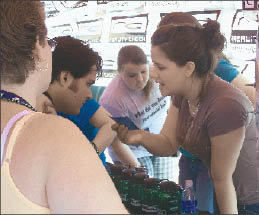 |
|
Youths at a music festival co-sponsored by Reality Check vie to win a water bottle by correctly answering a question about smoking.
Photo: Reality Check
|
Ballston Spa, N.Y.
(518) 885-8995
http://www.realitycheckny.org
The Approach: Each year, teens in this youth-led program select initiatives to fight tobacco companies that they believe target teens in their marketing efforts. This year, the youths are running a Smoke-Free Movies campaign that tries to get municipalities to rate movies “R” if they show tobacco use, to certify that no one was paid by a tobacco company to depict smoking in a movie and to mandate that anti-smoking public service announcements run before movies showing tobacco use.
Reality Check Coordinator Lauren Rowland oversees the twice-monthly meetings of the teens, who come up with ideas and marketing for their campaigns. Saratoga County sends a local youth representative to the annual meeting of Reality Check programs around the state.
Reality Check members have developed several campaigns over the years, including “Lead the Revolution” and “We Will Not Be Bought,” designed to encourage other young people not to be sucked in by the marketing of tobacco companies. The youths hand out Reality Check gear – including keychains and T-shirts – at local events, such as the county fair and school football games. Rowland says the gear is especially effective because adults are not supposed to wear or display the Reality Check logo.
“Kids respond because it’s edgy and cool,” Rowland says. “Plus, instead of alienating smokers, we’re going to the source of the problem – the tobacco companies.”
History and Organization: Saratoga County teens became involved in the statewide Reality Check movement in 2001. Rowland says the Cornell Cooperative Extension already had a strong youth program, and Reality Check seemed like an appealing way to make use of MSA funds from the state Department of Health.
Teens from all over New York received training on running anti-tobacco company campaigns at Keuka College through the Campaign for Tobacco Free Kids, then returned to their home counties to start their own Reality Check programs.
Youth Served: Saratoga County’s Reality Check has about 60 members, ages 13 to 18. Rowland says Reality Check runs in about half of Saratoga County’s 13 schools, and reaches around 500 students a year through middle school and high school health classes.
Staff: Rowland is the only Cooperative Extension staff member working on Reality Check.
Funding: Saratoga County’s Reality Check receives funding through MSA from the state Department of Health and from the Cornell Cooperative Extension. The budget runs from $85,000 to $145,000 each year.
Indicators of Success: Rowland says Saratoga County has no formal system for evaluating the effectiveness of Reality Check.
She says the group measures its success based on informal factors, including the fact that many local businesses, organizations and events – such as the Saratoga County Fair – sign resolutions saying they will not accept tobacco company sponsorship. Rowland says Reality Check’s events, which include dances and movie nights, usually draw 100 to 200 teens.
ASPIRE
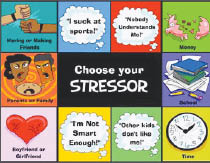 |
|
Choosey: ASPIRE’s computer program tailors anti-smoking messages and behavioral exercises to individual youths.
Photo: M.D. Anderson Cancer Center.
|
Division of Cancer Prevention and Population Sciences
The University of Texas
M.D. Anderson Cancer Center
Houston, Texas
(713) 745-3817
http://www.Adanderson.org/departments/aspire
The Approach: ASPIRE is a CD-Rom that is provided to kids in health classes; it takes about five hours to complete a whole program. The youths first select a “personality” that most closely matches theirs, and then engage in interactive activities that are tailored to their specific needs.
For example, one program is tailored to kids who smoke but aren’t interested in quitting. Another is for nonsmokers.
http://www.Bdanderson.org/departments/aspire
The program’s main architect, Dr. Alexander Prokhorov, says that too many anti-smoking efforts “stop at explaining the harms of tobacco, but don’t show kids how to be tobacco-free.” ASPIRE, he says, gives kids behavioral exercises to either quit smoking or avoid starting, by using animation, videos and quizzes tailored to individual youths.
Prokhorov says ASPIRE teaches kids not only about the health consequences of smoking, but about less apparent consequences, such as financial costs. The program also teaches nonsmoking kids how to be tobacco-control advocates and how to influence their peers.
Along with the CDs for students, ASPIRE provides DVDs to teachers, counselors and nurses about how to provide social support to kids who are smoking or who want to quit, and how to prevent youth from starting tobacco use. Prokhorov says this is especially essential for low-income kids who have little social support at home.
ASPIRE recently put a shorter version of its program online.
History and Organization: ASPIRE began as a research project in the Houston Independent School District in 2001. It was formed when the M.D. Anderson Cancer Center and the university’s Health Science Center won a grant from the National Cancer Institute to create a computer-based program to prevent smoking in young people and to help youth smokers quit.
Youth Served: ASPIRE’s pilot study in Houston involved 1,600 tenth-graders at 16 schools over the course of 18 months. The program has since expanded district-wide. Prokhorov says ASPIRE is designed to target middle school and high school kids in socially and economically depressed neighborhoods.
Staff: Prokhorov says about 10 faculty-level researchers, educators and technicians worked to design ASPIRE. One staff member from the Anderson Center disseminates information about the program to area schools and communities and helps to launch programs.
Funding: The creation of ASPIRE was funded by a grant of just over $2 million from the National Cancer Institute. The George and Barbara Bush Endowment for Innovative Cancer Research provided funding to put ASPIRE online (as opposed to being exclusively on CD).
Indicators of Success: The pilot project in Houston showed substantial success in preventing 10th-graders from becoming smokers. To track outcomes, the Anderson Center surveyed ASPIRE participants and a control group that received a basic self-help manual on not using tobacco products. Prokhorov says that after 18 months, the smoking initiation rate for ASPIRE participants was 2 percent, while the rate for the control group was 6 percent.
The difference is larger among “at-risk” kids. ASPIRE participants who suffered from depression had an initiation rate of 3 percent, while depressed kids in the control group had an initiation rate of 9 percent. Youth with low self-esteem who participated in ASPIRE showed an initiation rate of 7 percent, while the control group’s rate was 20 percent.
“The more risk factors you have, the more likely you’ll initiate smoking,” Prokhorov says. He says kids who participated in ASPIRE were better equipped to say “no” than those in the control group.
M.D. Anderson Cancer Center.
Virginia Tobacco Settlement Foundation Tobacco Use Prevention
Rockbridge Area Community Services
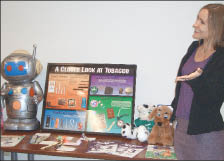 |
|
Robots, puppets and colorful displays create a focal point for Tashia Abry’s presentation of RACS’ “Too Good for Drugs” program.
Photo: Rockbridge Area Community Services.
|
Lexington, Va.
(540) 463-3141
http://www.racsb.org/pages/vtsf2.asp
The Approach: Rockbridge Area Community Services (RACS) uses funding from the Virginia Tobacco Settlement Foundation (VTSF) to run anti-tobacco and anti-drug programs in area schools, operating in a largely rural county with a smoking culture. VTSF has a variety of approved curricula, all of which involve prevention educators visiting each health or science classroom once a week for eight to 10 weeks.
Kelly Shifflett, RACS’ director of prevention and public relations, says the agency’s programming does include information on how tobacco and drug use can harm your health, using such characters as “Mr. Dip Lip.” But the lessons focus primarily on teaching kids how to lead healthy lifestyles, how to manage stress in positive ways and how to avoid bowing to peer pressure.
“Our main point is that not everybody is doing this,” she says. “Don’t think when you get to high school that you’ll be expected to drink and smoke.”
Shifflett says her educators use puppet shows or robots to get younger youths interested in the message, while they often employ role playing and skits with older students.
Sometimes they give out items to remind kids of what the program was about. One year, educators presented the story of a butterfly whose development was retarded because of bad life choices, then gave a model butterfly to each student. Shifflett says that years later, youths have come up to her and the educators to say they still have the butterflies in their lockers or on their desks as reminders to resist temptation.
Shifflett says a big advantage of Rockbridge’s program is that the students get the anti-tobacco education for eight weeks or more every school year. “It’s important that we inoculate kids each and every year,” she says. “Some of these kids have had this program for six years now, and they need the repetition.”
History and Organization: Virginia is one of 46 states that signed the Master Settlement Agreement with the nation’s four largest tobacco companies in 1998. It required the companies to pay the states for expenses associated with disease and health problems caused by tobacco use. The RACS tobacco prevention program was funded in the first round of Virginia’s MSA funding in 2000 under an 18-month contract. It has been renewed every year.
RACS also provides services for people suffering from mental illness and retardation, as well as substance abuse.
Youth Served: 800 to 1,000 youths annually in second through ninth grades at the city schools in Lexington and nearby Buena Vista.
Staff: The program has two part-time prevention educators, while Shifflett provides program and educator supervision.
Funding: VTSF provides $70,000 annually from the MSA funds. RACS provides about $8,000 out of its own budget, supplied from state general funds.
Indicators of Success: RACS and VTSF conduct annual evaluations to determine the program’s effectiveness. The RACS evaluation consists of pre-program and post-program tests of youths about their knowledge of tobacco and drugs, the negative effects, how to resist peer pressure and how to healthfully manage stress. In the 2005-06 school year, 74 percent of students evaluated showed improvement in their knowledge. Shifflett says that in VTSF’s annual evaluation, Rockbridge’s students consistently score better than the state average. For example, in the 2005-06 school year, third-graders in Rockbridge scored 2.81 on a scale of 0 to 3, compared with the state average of 2.72.
Shifflett says neither RACS nor VTSF does any longitudinal studies to see how participants fare in the long term.




